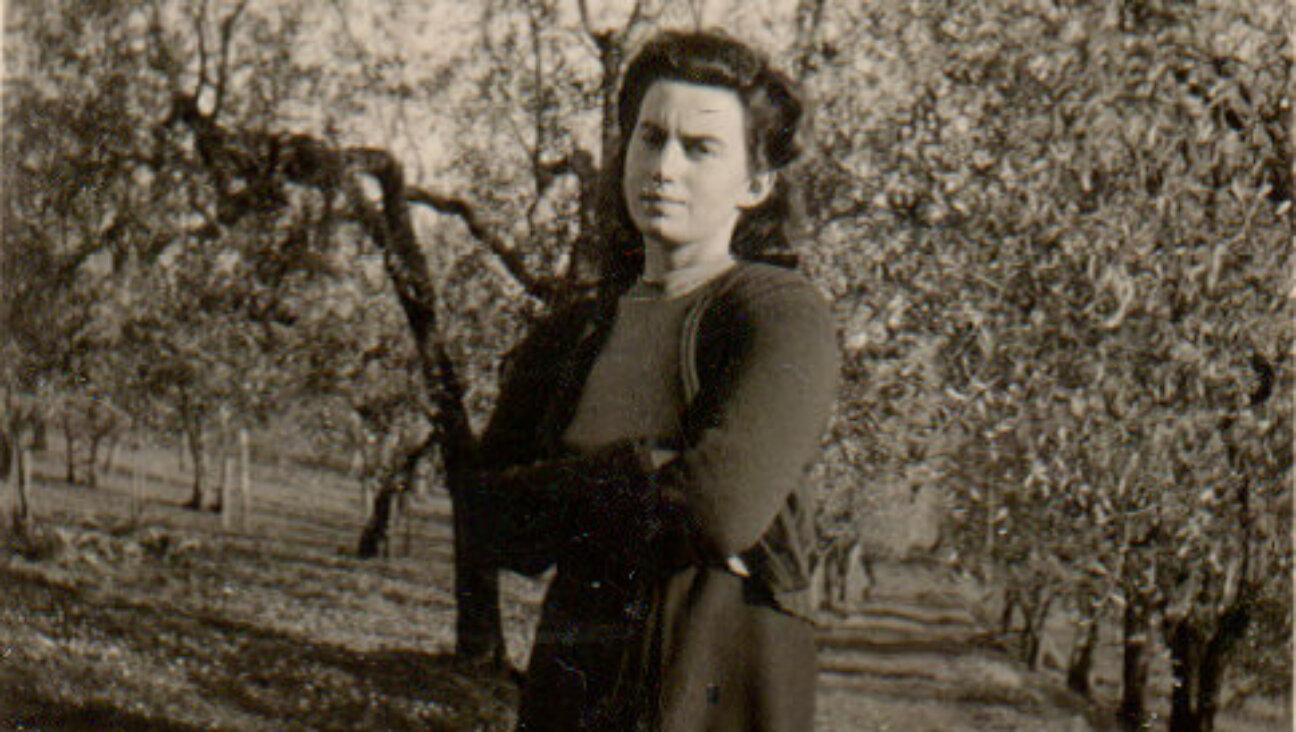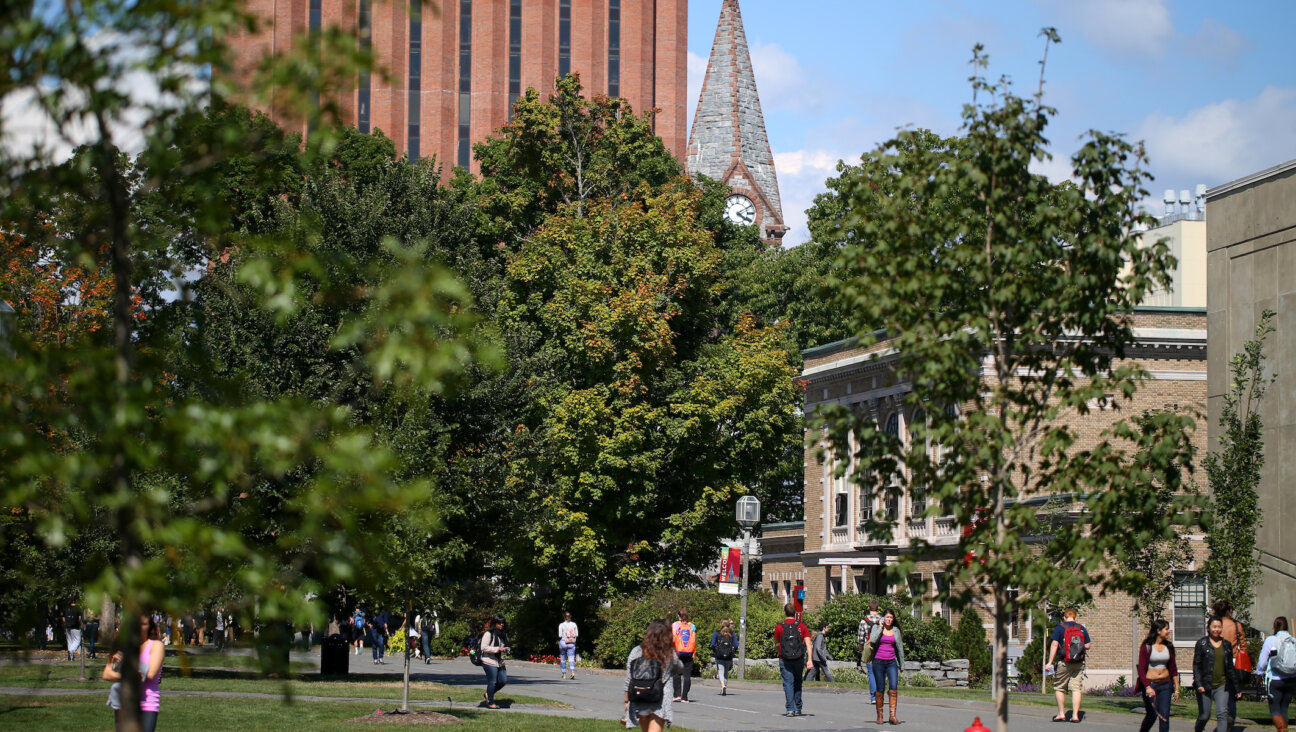Noam Shalit, the Israeli father whose campaign led to the release of his captive son, dies at 68

In this handout photo provided by the Israel Defenses Force, freed Israeli soldier Gilad Shalit (L) walks with his father Noam Shalit at Tel Nof Airbase, Oct. 18, 2011. (Israel Defense Forces via Getty Images)
(JTA) — When Noam Shalit first learned that his son, Gilad, had disappeared, his thoughts turned to his own father.
Noam’s twin brother, Yoel, went missing in the Golan Heights in 1973 during the Yom Kippur War. Their father immediately set off for the war battered plateau to search for Yoel, who was 19, the same age as Gilad when Hamas militants kidnapped him in in 2006 a cross-border raid.
Yoel was eventually identified among the dead. The fear that Gilad, an introverted basketball fan, might share the same fate drove Noam Shalit to shed his natural inclination for privacy, and to become the face of a campaign to reclaim his son, culminating in a prisoner exchange in 2011.
“It was like being thrown over 30 years backward,” Noam Shalit told The New York Times just months after he launched the campaign to free Gilad.
Noam Shalit died Wednesday, at age 68, exactly 13 years after moving with his wife into a tent outside the prime minister’s residence in Jerusalem to call attention to his son’s captivity. He was suffering from leukemia, Ynet, the Israeli news site, reported.
Benny Gantz, the defense minister, who was military chief in 2011 and helped negotiate Gilad Shalit’s release, said in his condolences that “he never once gave up the hope that he would see his son again.”
His son’s capture forced Shalit, an engineer, to become the public face of a movement. His fierce paternal love throbbed through the cloak of his calm demeanor, and he earned the devotion of Israeli parents, locked in a cycle of lavishing attention on their children and then relinquishing them to the maw of perpetual risk of death or capture.
“I’m here because if it was my son, I would want someone to support me as well.” Michal Naamani, a protester handing out yellow ribbons, told the Jewish Telegraphic Agency in 2011, not long before the exchange of 1,027 Palestinian security prisoners won Shalit’s release.
“Gilad Shalit is a national trauma,” Sima Kadmon, a Yediot Ahronot columnist, wrote in 2010. “He is the symbol of our powerlessness. Of the fact that the Israel Defense Forces cannot solve everything and of the fact that not everything can be fixed by force, and perhaps, of the fact that not everything can always be resolved.”
Noam Shalit was relentless, and irked successive Israeli governments, much as they paid lip service to his campaign. Previous massive exchanges of a handful of Israeli prisoners or corpses for thousands of suspected terrorists had come to be seen as a bad deal: Sometimes, the terrorists went back to work almost immediately upon being freed.
But it was hard to resist Noam Shalit’s steady campaign. Posters of Gilad Shalit in a uniform, thin, boyish and awkward, plastered the country’s public spaces. Noam Shalit appealed directly to Palestinians. He offered Hamas to become a hostage to release his son. In 2010, Noam Shalit led a march from his village in Israel’s north to Jerusalem. “We won’t wait any longer in our home,” he said, setting out on the march.
“This is a debate between the head and heart, and everyone has both,” Yaacov Amidror, a general in the Israeli reserves, said at the time, reflecting the popular security establishment view. “Those who let the head take over feel that there is a limit to what a state should pay. I believe that in principle negotiations should not be held with terror organizations.”
Israeli Prime Minister Benjamin Netanyahu eventually took another view, acceding to the hearts of Noam Shalit and his supporters and made the trade. Victims of the terrorists among those freed shed tears of frustration upon their release, but scenes of Gilad and Noam reuniting overwhelmed the news, and polls showed Israelis supported the terms of the release.
Noam Shalit tarried for a while in the limelight, contemplating a run for Knesset in 2012 on the Labor Party ticket — his experience with his son nurtured a contempt for hard lines, and he said he would talk to Hamas to make peace.
Soon, however, the family returned to its private ways. If Noam Shalit made a public appearance, it was to thank supporters, to whom he remained intensely grateful. “The feeling that the country was behind us was overwhelming,” he told Israeli expats in California in 2014. “What started as a lonely crusade turned into a mass movement.”
In 2020, Gilad Shalit and his fiancee, Nitzan Shabbat, announced via Instagram that they were engaged ; The photo of the robust, intensely happy couple was their one concession to a public that wondered what happened to the wan bespectacled boy who disappeared.
When they married five months later, the family invited family and close friends, who were asked to sign nondisclosure agreements.
—
The post Noam Shalit, the Israeli father whose campaign led to the release of his captive son, dies at 68 appeared first on Jewish Telegraphic Agency.
The Forward is free to read, but it isn’t free to produce

I hope you appreciated this article. Before you go, I’d like to ask you to please support the Forward.
Now more than ever, American Jews need independent news they can trust, with reporting driven by truth, not ideology. We serve you, not any ideological agenda.
At a time when other newsrooms are closing or cutting back, the Forward has removed its paywall and invested additional resources to report on the ground from Israel and around the U.S. on the impact of the war, rising antisemitism and polarized discourse.
This is a great time to support independent Jewish journalism you rely on. Make a gift today!
— Rachel Fishman Feddersen, Publisher and CEO
Support our mission to tell the Jewish story fully and fairly.
Most Popular
- 1

Fast Forward Ye debuts ‘Heil Hitler’ music video that includes a sample of a Hitler speech
- 2

Opinion It looks like Israel totally underestimated Trump
- 3

Culture Cardinals are Catholic, not Jewish — so why do they all wear yarmulkes?
- 4

Fast Forward Student suspended for ‘F— the Jews’ video defends himself on antisemitic podcast
In Case You Missed It
-

Culture How one Jewish woman fought the Nazis — and helped found a new Italian republic
-

Opinion It looks like Israel totally underestimated Trump
-

Fast Forward Betar ‘almost exclusively triggered’ former student’s detention, judge says
-

Fast Forward ‘Honey, he’s had enough of you’: Trump’s Middle East moves increasingly appear to sideline Israel
-
Shop the Forward Store
100% of profits support our journalism
Republish This Story
Please read before republishing
We’re happy to make this story available to republish for free, unless it originated with JTA, Haaretz or another publication (as indicated on the article) and as long as you follow our guidelines.
You must comply with the following:
- Credit the Forward
- Retain our pixel
- Preserve our canonical link in Google search
- Add a noindex tag in Google search
See our full guidelines for more information, and this guide for detail about canonical URLs.
To republish, copy the HTML by clicking on the yellow button to the right; it includes our tracking pixel, all paragraph styles and hyperlinks, the author byline and credit to the Forward. It does not include images; to avoid copyright violations, you must add them manually, following our guidelines. Please email us at [email protected], subject line “republish,” with any questions or to let us know what stories you’re picking up.













